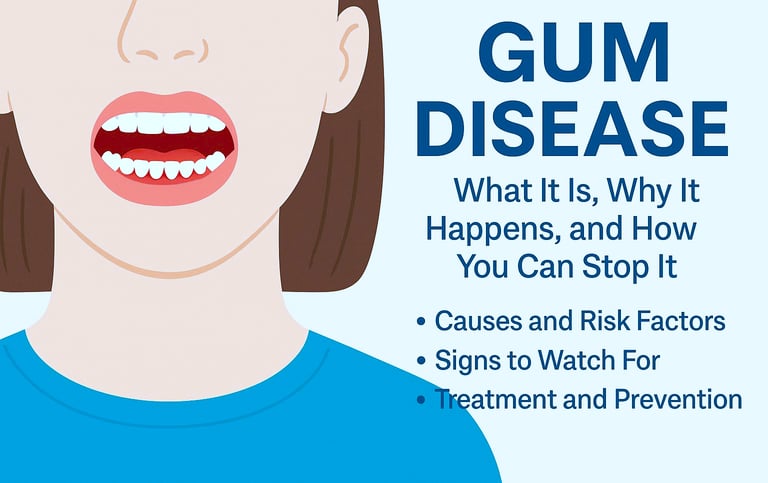Stay updated on what is trending in health. Discover tips and resources for a healthier, balanced life.
Gum Disease: What It Is, Why It Happens, and How You Can Stop It
Gum disease affects your smile more than you think. Learn what causes it, how to spot early signs, and the best ways to treat and prevent it—before it leads to tooth loss.
DISEASES AND CONDITIONS
Dr. S. Ali
8/18/20255 min read


Let’s Talk About Gum Disease
Do your gums bleed when you brush? Feel sore or look swollen? It might be easy to brush it off (pun intended), but those could be early signs of gum disease — also called periodontal disease.
You’re not alone. Gum disease is incredibly common, but the good news is: it’s also very treatable and even preventable with the right care.
What Is Gum Disease Anyway?
Gum disease is an inflammation of the gums that, if left untreated, can affect the bone that supports your teeth. There are two main stages:
Gingivitis – the mild, early stage. Gums may look red, swollen, or bleed easily. It’s usually reversible with good oral hygiene.
Periodontitis – the more serious stage. The infection spreads below the gum line, damaging the tissue and bone holding your teeth in place. This can lead to loose teeth — or even tooth loss.
Why Does It Happen?
Gum disease starts with plaque, a sticky film of bacteria that forms on your teeth. If not removed by brushing and flossing, plaque hardens into tartar, which can only be removed by a dental professional. Over time, tartar buildup irritates the gums and causes inflammation.
Common Causes & Risk Factors
Poor brushing and flossing habits – Skipping daily cleaning lets plaque harden into tartar, irritating gums and causing inflammation (gingivitis).
Smoking or using tobacco – Reduces blood flow to gums, weakens healing, and doubles the risk of severe periodontitis.
Hormonal changes (pregnancy/menopause) – Fluctuations increase gum sensitivity to bacteria, often causing "pregnancy gingivitis" or dry mouth.
Diabetes – High blood sugar fuels infections, making gums more prone to swelling and slow healing after damage.
Saliva-reducing medications (e.g., antihistamines, antidepressants) – Dry mouth allows bacteria to thrive unchecked.
Genetics – Some inherit overactive immune responses to oral bacteria, raising gum disease risk even with good hygiene.
Key Tip: Early gum disease (gingivitis) is reversible with care—catch it before it becomes periodontitis (bone loss)!
Signs of Gum Disease – Don’t Ignore These!
Gums that bleed easily – Healthy gums shouldn’t bleed from gentle brushing/flossing. This is often the first warning sign of gingivitis.
Red, swollen, or tender gums – Inflammation means your body is fighting bacteria. Bright red or puffy gums aren’t normal.
Persistent bad breath – Foul odors that won’t go away may signal bacteria buildup below the gumline.
Receding gums – If teeth appear longer, gums may be pulling away due to infection, exposing vulnerable roots.
Pain when chewing – Discomfort could mean advanced gum damage or abscesses forming.
Loose or sensitive teeth – Bone loss from periodontitis weakens tooth support—act fast to prevent tooth loss.
Pus between teeth/gums – A clear sign of active infection (abscess) needing urgent dental care.
Key Takeaway:
Early-stage gum disease (gingivitis) is reversible with better oral care. But once it progresses to periodontitis, the damage becomes harder to stop. See your dentist ASAP if you spot these signs!
How Is Gum Disease Treated?
The earlier it’s caught, the easier it is to treat. For gingivitis, most people just need a professional cleaning and a renewed commitment to brushing and flossing.
If the disease has progressed to periodontitis, your dentist or periodontist may recommend:
Deep cleaning (scaling and root planing) – to remove tartar and bacteria from below the gum line
Antibiotics – to treat the infection
Surgery – in severe cases, procedures like flap surgery or bone grafting may be needed
Can You Prevent Gum Disease? Yes! Here’s How:
Brush twice daily with fluoride toothpaste – Fluoride strengthens enamel while brushing removes plaque before it hardens into destructive tartar. Pro tip: Use a soft-bristled brush at a 45-degree angle to gums.
Floss daily – Toothbrushes can’t reach 40% of tooth surfaces. Flossing removes plaque between teeth where gum disease often starts. String floss or water flossers both work!
Regular dental cleanings/checkups – Even perfect brushers need professional cleanings every 6 months to remove tartar and catch early signs you might miss.
Don’t skip flossing (seriously!) – Gums bleed at first? That’s why you need to keep flossing – it gets better as gum health improves.
Quit smoking – Tobacco compromises blood flow to gums, slows healing, and quadruples your risk of severe periodontitis.
Eat a gum-friendly diet – Crunchy fruits/veggies stimulate saliva (nature’s mouthwash), while vitamin C (citrus, bell peppers) strengthens gum tissue. Avoid sticky sweets that feed bacteria.
How to Deal with Gum Disease in Children
1. Know What to Look For
Gum disease in kids may not seem obvious at first, but here are some early signs to watch out for:
Red, swollen, or puffy gums
Bleeding during brushing or flossing
Persistent bad breath (not just "morning breath")
Receding gums — teeth may start to look "longer"
Sensitivity when eating or brushing
If you spot any of these, it’s time for a dental checkup.
2. Prioritize Oral Hygiene (Together)
The main cause of gum disease is plaque buildup — and kids are no exception. Daily brushing and flossing are key.
What to do:
Help younger kids brush their teeth twice a day with fluoride toothpaste.
Teach proper brushing techniques — gentle circles at the gum line, not harsh scrubbing.
Floss once a day — floss sticks or floss picks can be easier for small hands.
For older children, supervise until you're sure they can do it well on their own (usually around age 7–8).
3. Schedule Regular Dental Visits
Routine dental checkups every 6 months are essential — not just for cavity prevention but to catch gum issues early. Dentists can remove hardened plaque (tartar), which brushing alone can't fix.
Professional tip: Many pediatric dentists make cleanings fun and educational for kids!
4. Use Kid-Friendly Tools
Make dental care less of a chore:
Choose a colorful toothbrush or one with their favorite cartoon character.
Try a fun timer or app that plays music for 2 minutes.
Use flavored flossers or water flossers designed for children.
5. Watch Their Diet
Too many sugary snacks and drinks can fuel the bacteria that cause gum disease. Encourage:
More fruits and vegetables
Water instead of juice or soda
Limiting sticky or sugary snacks
6. Don’t Ignore Mouth Breathing
Chronic mouth breathing can dry out gums, increasing the risk of gum inflammation. If your child breathes through their mouth at night, mention it to your pediatrician or dentist — it could be a sign of enlarged tonsils or nasal issues.
7. Address Habits Like Teeth Grinding or Thumb Sucking
These habits can irritate the gums or misalign teeth, which might contribute to gum problems. Dentists can suggest gentle ways to help kids break the habit if it persists past early childhood.
When to See a Specialist
If your child’s gum disease doesn’t improve with better brushing, your dentist may refer you to a pediatric periodontist. In rare cases, gum disease in children could be linked to other health conditions like diabetes or immune system disorders — so don’t ignore persistent symptoms.
Final Thoughts
Gum disease can affect both adults and children, but it doesn't have to lead to lasting damage. Whether you're dealing with bleeding gums in your own mouth or noticing early signs in your child, the key is early detection, daily care, and regular dental checkups.
With a little effort — and some help from your dental team — you can keep gums healthy, smiles bright, and avoid bigger problems down the road. Prevention really is the best treatment.
Sources
American Dental Association (ADA) – Gum Disease
https://www.mouthhealthy.org/all-topics-a-z/gum-diseaseCenters for Disease Control and Prevention (CDC) – Periodontal Disease
https://www.cdc.gov/oralhealth/conditions/periodontal-disease.htmlNational Institute of Dental and Craniofacial Research (NIDCR)
https://www.nidcr.nih.gov/health-info/gum-diseaseMayo Clinic – Gingivitis and Periodontitis
https://www.mayoclinic.org/diseases-conditions/gingivitis/symptoms-causes/syc-20354453NHS UK – Gum Disease (Gingivitis and Periodontitis)
https://www.nhs.uk/conditions/gum-disease/
American Academy of Pediatric Dentistry (AAPD)
https://www.aapd.org/research/oral-health-policies--recommendations/HealthyChildren.org – Oral Health in Kids (by the American Academy of Pediatrics)
https://www.healthychildren.org/English/healthy-living/oral-health
Pulse Your Health
Empowering you to achieve your health goals.
Contact
© 2025. All rights reserved.
Disclaimer: The content on this website is for informational purposes only and is not medical advice. Always seek the advice of your physician or other suitably qualified healthcare professional for diagnosis, treatment and your health related needs.
